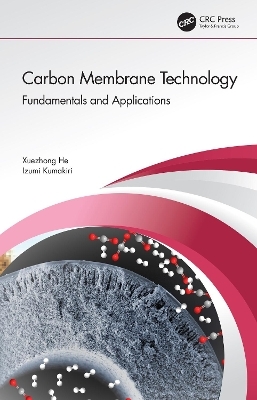
Carbon Membrane Technology
CRC Press (Verlag)
978-0-367-61944-2 (ISBN)
Carbon membranes have great advantages of strong mechanical strength and high chemical stabilities, as well as high separation performance to reach the industrial attractive region. Further improvement on membrane performance can potentially offset the relatively high production cost compared to polymeric membranes. However, there are still some challenges related to fabrication of asymmetric carbon membranes, the controlling of structure and pore-size and module up-scaling for commercial application. The aim of this book is to provide the fundamentals on carbon membrane materials for the young researchers and engineers to develop frontier membrane materials for energy efficient separation process.
This book describes the status and perspectives of both self-supported and supported carbon membranes from fundamentals to applications. The key steps on the development of high performance carbon membranes including precursor selection, tuning carbon membrane structure and regeneration are discussed. In the end, different potential applications both in gas and liquids separation are well described, and the future directions for carbon membrane development were pointed out.
To this end, membrane science and engineering are set to play crucial roles as enabling technologies to provide energy efficient and cost-effective future solutions for energy and environment related processes. Based on this approach the research projects which are trying to find attractive carbon materials in our days are many. The published papers, per year, in the topic of carbon membranes, especially for biogas upgrading, natural gas sweetening and hydrogen purification, are numerous with very high impact. However, only few are the books which include relevant to the topic of carbon membrane technology. This book offers the condensed and interdisciplinary knowledge on carbon membranes, and provides the opportunity to the scientists who are working in the field of carbon membrane technology for gas and liquid separations to present, share, and discuss their contributions within the membrane community.
Xuezhong He is an associate professor at Guangdong Technion Israel Institute of Technology (GTIIT) and Technion-Israel Institute of Technology, who has been working in the Department of Chemical Engineering at Norwegian University of Science and Technology (NTNU) for more than 10 years in membrane science and engineering. Dr. He has solid knowledge of and high competence in membrane materials (both polymeric and carbon membranes in flat sheets and hollow fibers) for energy-related separation processes, especially natural gas sweetening, biogas upgrading, and hydrogen purification. Dr. He has published >40 articles in peer-reviewed journals such as J. Member. Sci., Chem. Eng. J., AIChE J., I&EC Res., and has >2000 citations and an H-index of 20 (Google Scholar), and has contributed eight chapters to books; Dr. He has also given a number of presentations at international conferences. Izumi Kumakiri is from Yamaguchi University Japan, having previously worked at National Center for Scientific Research (CNRS), France, and at Stiftelsen for industriell og teknisk forskning (SINTEF), Norway, and is involved in various national, international, and industrial projects on the developments and the applications of membranes and nano-functionalized materials. Professor Kumakiri is currently conducting research projects related to the developments of microporous inorganic membranes including carbon, zeolite, and other types, and their applications in energy and environmental fields, and has published more than 50 articles in leading scientific journals.
Contents
Preface vii
Editors xi
Part 1. Fundamentals of Carbon Membranes
1. Carbon Membrane Preparation....................................................................3
Linfeng Lei and Xuezhong He
2. Carbon Membrane Performance: State-of-the-Art..................................21
Linfeng Lei and Xuezhong He
3. Carbon Membrane Characterization..........................................................37
Linfeng Lei
4. Carbon Membrane Transport Mechanisms..............................................53
Xuezhong He
Part 2. Carbon Membrane Applications
5. Carbon Membranes for Biogas Upgrading...............................................65
Arne Lindbråthen
6. Carbon Membranes for Natural Gas Sweetening...................................79
Evangelos P. Favvas, Sotirios P. Kaldis and Xuezhong He
7. Carbon Membranes for H2 Purification................................................... 115
Miki Yoshimune
8. Carbon Membranes for Microfiltration/
Ultrafiltration/Nanofiltration.....................................................................131
Bing Zhang and Yonghong Wu
vi Contents
9. Carbon Membranes for Other Applications..........................................151
Sergio San Martin Gomez, Izumi Kumakiri and Xuezhong He
10. Future Perspectives......................................................................................159
Xuezhong He
Index......................................................................................................................163
| Erscheinungsdatum | 28.09.2023 |
|---|---|
| Zusatzinfo | 13 Tables, black and white; 38 Illustrations, black and white |
| Verlagsort | London |
| Sprache | englisch |
| Maße | 156 x 234 mm |
| Gewicht | 80 g |
| Themenwelt | Naturwissenschaften ► Chemie ► Technische Chemie |
| Technik ► Elektrotechnik / Energietechnik | |
| Technik ► Umwelttechnik / Biotechnologie | |
| ISBN-10 | 0-367-61944-X / 036761944X |
| ISBN-13 | 978-0-367-61944-2 / 9780367619442 |
| Zustand | Neuware |
| Haben Sie eine Frage zum Produkt? |
aus dem Bereich


